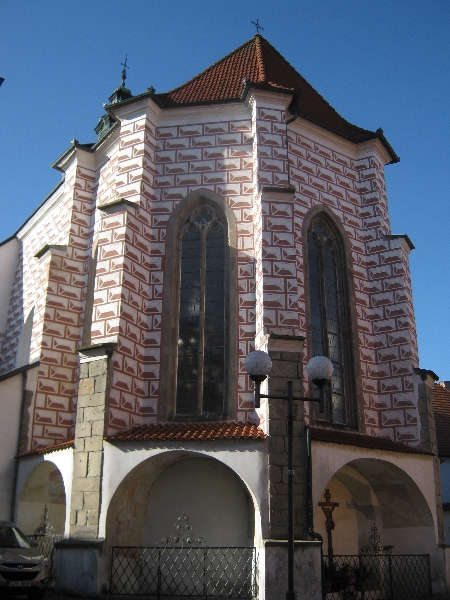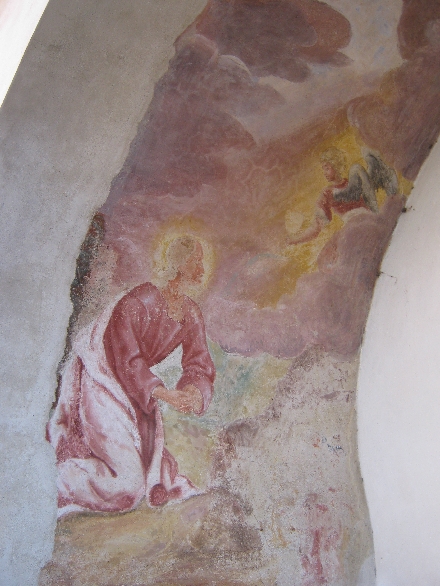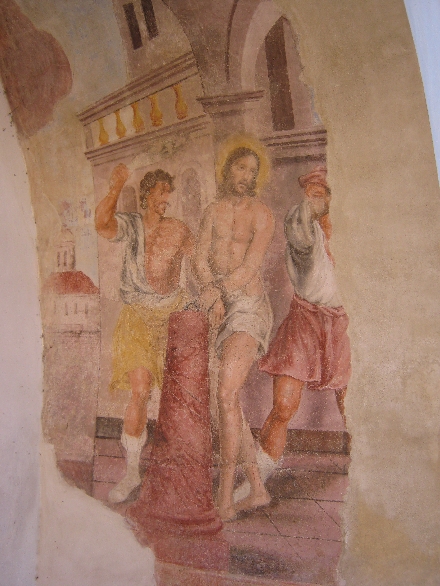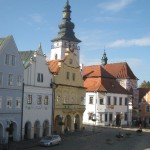
For a number of reasons, I took my day-off this week today, rather than yesterday. Taking advantage of some wonderful Indian summer weather, Sybille and I drove just over one hundred kilometres south-east of Prague and explored the interesting historic town of Pelhrimov. A much longer and more detailed post about the town will follow shortly. But tonight, I just wanted to post about one fascinating discovery that we made today, whilst exploring this delightful town.
At one corner of Masarykovo námestí, the main square in the centre of Pelhrimov, is the Church of St Bartholomew – kostel sv Bartolomej. The Church dates from the late thirteenth/early fourteenth century and much of its exterior walls are decorated with sgraffiti as can be seen in this photograph. But in the small curved alcoves on the outside of the chancel walls, we found the remains of several frescos. I have no idea either as to their origin or of their age, but my educated guess is that they are probably several centuries old.

This first one is a depiction of the presentation of Christ in the Temple, as described in Luke 2. 22-40. At the top of the fresco is Simeon, holding the infant Jesus. Next to Jesus is his mother Mary, in blue. Next to her, is the prophetess Anna, whilst at the bottom left is Joseph.

This second fresco is of Jesus praying in the Garden of Gethsemane on the night before his crucifixion. Jesus is shown praying to his Father saying, ‘Yet not what I will, but what you will.’ Mark 14. 36. The artist portrays Jesus receiving angelic support from above.

This third fresco shows a scourged Jesus being presented to the people. The scene is often called Ecce homo, the Latin words for ‘Behold the man’, found in John 19. 5.
I am quite amazed as how this wonderful artwork has actually survived all these years, despite the physical elements of rain and snow, and nearly forty-two years of Communist rule.


What a find, Ricky! I love frescoes and these are very fine, despite all the depredations of time and weather. The sgraffiti decoration is rather striking too.
What a find indeed, Perpetua! And no mention of the frescos in any guidebook in our possession. Yes – the sgraffiti is impressive but wait until you see my next post about our visit to Pelhrimov and you’ll see a further amazing variety of most attractive architecture & decoration.
I’ve tried to look up some information about the frescoes you mention, Ricky. However, the only thing I was able to find is that they were discovered only recently during some restoration works and that they date back to the Renaissance period (16th century, around the same time when the walls were covered with the red-white sgraffiti).
Hello Jan F. & welcome to my blog as I think this the first time you’ve left a comment here. Thank you so much for this additional information as my little bit of internet research produced absolutely nothing. Presumably the frescos had been previously covered over with whitewash or something similar. I’d also be interested to know the source of your information, even though I’m sure it will be only in Czech 🙂
Thank you for your warm welcome, Ricky. Indeed, the information I found is available only in Czech – see here http://www.turistik.cz/cz/kraje/vysocina/okres-pelhrimov/pelhrimov/kostel-sv-bartolomeje-s-vyhlidkovou-vezi/ or here http://www.kudyznudy.cz/Aktivity-a-akce/Aktivity/Kostel-sv–Bartolomeje-v-Pelhrimove.aspx . Also, when searching for relevant information I came across this biography of F.B.Vanek, former chaplain and then dean of the Church of St. Bartholomew from 1906 to 1943 – https://sites.google.com/site/frantisekbernardvanek18721943/zivotopis . Not only he stood behind the commission of some interesting works of art for the church but was also present at the discovery of the red-white sgraffito in 1924 which has been completely uncovered since…
You are most welcome Jan F.! Thank you for your very prompt reply & for these most helpful links.